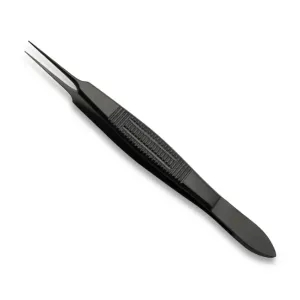Precision in Aesthetic Surgery: Understanding Blepharoplasty Forceps and Instruments
This comprehensive guide delves into the role and nuances of blepharoplasty forceps and related instruments, shedding light on their importance, types, and usage in eyelid surgeries.

Introduction
Blepharoplasty is a delicate surgical procedure that enhances the appearance or functionality of the eyelids. To achieve optimal results, surgeons rely on specialized tools tailored for precision, including blepharoplasty forceps, blepharoplasty scissors, and other instruments. These tools are essential for ensuring patient safety, Comfort, and the aesthetic success of the operation.
This comprehensive guide delves into the role and nuances of blepharoplasty forceps and related instruments, shedding light on their importance, types, and usage in eyelid surgeries.
What Are Blepharoplasty Forceps?
Blepharoplasty forceps are specialized tools used in eyelid surgery to hold, grasp, or manipulate delicate tissues. These instruments are pivotal in maintaining precision, minimizing trauma, and ensuring smooth surgical outcomes. They are designed with fine tips and ergonomic grips to accommodate the surgeon's need for accsurgeons to confine their areas around the eyes.
Features of Blepharoplasty Forceps
-
Fine-Tipped Design: Enables precise handling of the eyelid's delicate tisseyelid'sonomic Grip: Reduces hand fatigue during lengthy procedures.
-
Variety of Types: Includes tissue forceps, tying forceps, and serrated or non-serrated variants for different surgical steps.
These features make blepharoplasty forceps indispensable for achieving aesthetic and functional outcomes.
Types of Blepharoplasty Instruments
A successful blepharoplasty procedure relies on a set of carefully designed instruments. These tools, including forceps, are chosen based on the specific needs of the surgery. Below are some common categories:
1. Blepharoplasty Forceps
-
Tissue Forceps: Used for grasping and manipulating tissues with minimal trauma.
-
Tying Forceps: Designed for knot tying during suturing.
-
Hemostatic Forceps: Used to control bleeding by clamping blood vessels.
2. Blepharoplasty Scissors
Blepharoplasty scissors are tailored to cut tissues with extreme precision. They are handy for excising excess skin and fat or during the dissection phase of the procedure. Popular types include:
-
Stevens Scissors: Known for their delicate, curved tips.
-
Westcott Scissors: Commonly used for delicate dissections.
-
Iris Scissors: Versatile instruments for cutting tissues and sutures.
3. Other Essential Instruments
-
Scalpel: Utilized for making precise incisions.
-
Needle Holders: Help secure needles during suturing.
-
Retractors: Hold back tissues for better visibility and access.
-
Cannulas: Assist in fat removal during eyelid surgery.
Combining these instruments ensures the surgeon can perform each step meticulously, ultimately leading to successful outcomes.
Importance of High-Quality Blepharoplasty Instruments
The quality of blepharoplasty instruments, including forceps and scissors, directly influences the procedure's success. Hprocedure's tools offer the following benefits:
1. Enhanced Precision
Blepharoplasty is a procedure where millimetres matter. Instruments with fine, sharp tips allow surgeons to execute each movement with exactness, preserving vital tissues and structures.
2. Reduced Patient Trauma
Minimally invasive techniques require instruments that do not bruise or damage tissues unnecessarily. This reduces post-operative swelling, pain, and recovery time.
3. Durability and Reliability
Surgeons must rely on instruments that retain their sharpness and functionality over time. Durable materials, such as stainless steel, ensure long-lasting performance.
4. Infection Control
Premium instruments are more straightforward to sterilize and maintain, minimizing the risk of infection. Surgical-grade materials resist corrosion and maintain their integrity even after repeated sterilizations.
How to Choose the Right Blepharoplasty Instruments
Selecting the appropriate blepharoplasty forceps and scissors requires a careful evaluation of the procedure's needs and procedure's's preferences. Surgeon's some factors to consider:
1. Type of Surgery
Upper and lower eyelid surgeries may require different tools. For example, forceps for handling the delicate tissues of the lower eyelid may differ from those used for the upper eyelid.
check more latest details related to the fat Injection Cannulas
2. Ergonomics
Instruments with ergonomic designs reduce strain on the surgeon's hand, improve and improve surgeons and performance procedures.
3. Material Quality
Surgical instruments made from high-quality stainless steel or titanium offer superior durability and ease of maintenance.
4. Manufacturer Reputation
Purchasing from reputable manufacturers ensures that the instruments meet rigorous quality standards.
5. Customization
Some surgeons prefer custom-designed instruments to suit their unique techniques and preferences. Collaborating with manufacturers to tailor tools can enhance surgical outcomes.
Maintenance of Blepharoplasty Forceps and Instruments
Proper maintenance of surgical instruments is vital for ensuring their longevity and functionality. The following steps are recommended:
1. Immediate Cleaning
Rinse instruments immediately after use to remove blood and debris. For thorough cleaning, use a soft brush and enzymatic detergent.
2. Inspection
Regularly inspect instruments for signs of wear, corrosion, or damage. Replace any compromised tools promptly.
3. Sterilization
Autoclaving is the standard method for sterilizing blepharoplasty instruments. Ensure that instruments are fully dry before storage to prevent corrosion.
4. Storage
Store instruments in a clean, dry environment. Use protective cases or trays to avoid damage during transportation.
The Role of Blepharoplasty Forceps in Modern Eyelid Surgery
As the demand for blepharoplasty continues to rise, the role of blepharoplasty forceps and other instruments becomes even more significant. These tools enable surgeons to adopt advanced techniques with precision and confidence, such as laser-assisted blepharoplasty and minimally invasive approaches.
Modern forceps, scissors, and instruments are engineered to accommodate these advancements, ensuring patients receive the best possible care with minimal downtime and exceptional results.
Conclusion
Blepharoplasty forceps, scissors, and other specialized instruments are indispensable for successful eyelid surgeries. Their precision, quality, and versatility allow surgeons to perform delicate procedures with minimal risks and optimal outcomes. Surgeons can ensure lasting performance and patient satisfaction by investing in high-quality blepharoplasty instruments and adhering to proper maintenance practices.
Whether you are a medical professional seeking the best tools for your practice or someone considering blepharoplasty, understanding the importance of these instruments provides valuable insight into the meticulous nature of this transformative procedure. With the right tools and techniques, blepharoplasty can deliver remarkable results that enhance function and aesthetics.
What's Your Reaction?
















